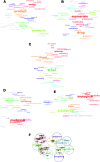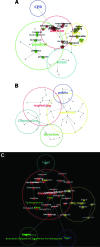Examination of the regulatory frameworks applicable to biologic drugs (including stem cells and their progeny) in Europe, the U.S., and Australia: part II--a method of software documentary analysis
- PMID: 23283552
- PMCID: PMC3659673
- DOI: 10.5966/sctm.2012-0038
Examination of the regulatory frameworks applicable to biologic drugs (including stem cells and their progeny) in Europe, the U.S., and Australia: part II--a method of software documentary analysis
Abstract
A wide range of regulatory standards applicable to production and use of tissues, cells, and other biologics (or biologicals), as advanced therapies, indicates considerable interest in the regulation of these products. The objective of this study was to analyze and compare high-tier documents within the Australian, European, and U.S. biologic drug regulatory environments using qualitative methodology. Eighteen high-tier documents from the European Medicines Agency (EMA), U.S. Food and Drug Administration (FDA), and Therapeutic Goods Administration (TGA) regulatory frameworks were subject to automated text analysis. Selected documents were consistent with the legal requirements for manufacturing and use of biologic drugs in humans and fall into six different categories. Concepts, themes, and their co-occurrence were identified and compared. The most frequent concepts in TGA, FDA, and EMA frameworks were "biological," "product," and "medicinal," respectively. This was consistent with the previous manual terminology search. Good Manufacturing Practice documents, across frameworks, identified "quality" and "appropriate" as main concepts, whereas in Good Clinical Practice (GCP) documents it was "clinical," followed by "trial," "subjects," "sponsor," and "data." GCP documents displayed considerably higher concordance between different regulatory frameworks, as demonstrated by a smaller number of concepts, similar size, and similar distance between them. Although high-tier documents often use different terminology, they share concepts and themes. This paper may be a modest contribution to the recognition of similarities and differences between analyzed regulatory documents. It may also fill the literature gap and provide some foundation for future comparative research of biologic drug regulations on a global level.
Figures




Similar articles
-
Examination of the regulatory frameworks applicable to biologic drugs (including stem cells and their progeny) in Europe, the U.S., and Australia: part I--a method of manual documentary analysis.Stem Cells Transl Med. 2012 Dec;1(12):898-908. doi: 10.5966/sctm.2012-0037. Epub 2012 Dec 4. Stem Cells Transl Med. 2012. PMID: 23283551 Free PMC article.
-
Descriptive Analysis of Good Clinical Practice Inspection Findings from U.S. Food and Drug Administration and European Medicines Agency.Ther Innov Regul Sci. 2022 Sep;56(5):753-764. doi: 10.1007/s43441-022-00417-w. Epub 2022 May 24. Ther Innov Regul Sci. 2022. PMID: 35610469 Free PMC article. Review.
-
2005 Donor Eligibility Requirements: Unintended Consequences for Stem Cell Development.Stem Cells Transl Med. 2015 Oct;4(10):1097-100. doi: 10.5966/sctm.2015-0045. Epub 2015 Aug 18. Stem Cells Transl Med. 2015. PMID: 26285658 Free PMC article.
-
A Review of Patient-Reported Outcomes Labeling for Oncology Drugs Approved by the FDA and the EMA (2012-2016).Value Health. 2019 Feb;22(2):203-209. doi: 10.1016/j.jval.2018.09.2842. Value Health. 2019. PMID: 30711065 Review.
-
Strategies to facilitate adolescent access to medicines: Improving regulatory guidance.Clin Trials. 2023 Feb;20(1):13-21. doi: 10.1177/17407745221132302. Epub 2022 Nov 5. Clin Trials. 2023. PMID: 36341541
Cited by
-
A Road Map to Commercialization of Cartilage Therapy in the United States of America.Tissue Eng Part B Rev. 2016 Feb;22(1):15-33. doi: 10.1089/ten.TEB.2015.0147. Epub 2015 Nov 5. Tissue Eng Part B Rev. 2016. PMID: 26192161 Free PMC article.
-
Exosomal therapy-a new frontier in regenerative medicine.Stem Cell Investig. 2021 Apr 2;8:7. doi: 10.21037/sci-2020-037. eCollection 2021. Stem Cell Investig. 2021. PMID: 33969112 Free PMC article. Review.
-
Exosomes in the Real World of Medical Aesthetics: A Review.Aesthetic Plast Surg. 2024 Jul;48(13):2513-2527. doi: 10.1007/s00266-023-03844-8. Epub 2024 Feb 5. Aesthetic Plast Surg. 2024. PMID: 38315231 Review.
-
Challenges and strategy in treatment with exosomes for cell-free-based tissue engineering in dentistry.Future Sci OA. 2021 Oct 28;7(10):FSO751. doi: 10.2144/fsoa-2021-0050. eCollection 2021 Dec. Future Sci OA. 2021. PMID: 34840808 Free PMC article. Review.
-
Mesenchymal Stem Cell-Derived Exosomes: A Potential Therapeutic Avenue in Knee Osteoarthritis.Cartilage. 2021 Dec;13(1_suppl):1572S-1585S. doi: 10.1177/1947603520962567. Epub 2020 Oct 5. Cartilage. 2021. PMID: 33016114 Free PMC article.
References
-
- Halme DG, Kessler DA. FDA regulation of stem-cell-based therapies. N Engl J Med. 2006;355:1730–1735. - PubMed
-
- FDA Guidance for industry: PAT—A framework for innovative pharmaceutical development, manufacturing, and quality assurance. 2004. [Accessed January 13, 2011]. Available at http://www.fda.gov/downloads/Drugs/GuidanceComplianceRegulatoryInformati....
-
- The Financing of Biopharmaceutical Product Development in Europe. Final Report. European Commission, Enterprise and Industry. 2009. Oct, [Accessed December 5, 2011]. Available at http://ec.europa.eu/enterprise/sectors/biotechnology/files/docs/financin....
-
- Advancing Regulatory Science at FDA, Strategic Plan: August 2011. Food and Drug Administration, U.S. Department of Health and Human Services. [Accessed December 5, 2011]. Available at http://www.fda.gov/regulatoryscience.
-
- Implementing the European Medicines Agency's Road Map to 2015: The Agency's Contribution to Science, Medicine, Health—From Vision to Reality. EMA/MB/550544/2011. 2011. Oct 6, [Accessed November 22, 2011]. Available at http://www.ema.europa.eu.
MeSH terms
Substances
LinkOut - more resources
Full Text Sources
Research Materials
Miscellaneous

